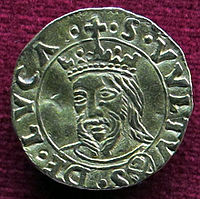
The House of Medici was an Italian banking family and political dynasty that first consolidated power in the Republic of Florence under Cosimo de' Medici, during the first half of the 15th century. The family originated in the Mugello region of Tuscany, and prospered gradually until it was able to fund the Medici Bank. This bank was the largest in Europe during the 15th century and facilitated the Medicis' rise to political power in Florence, although they officially remained citizens rather than monarchs until the 16th century.

Lucca is a city and comune in Tuscany, Central Italy, on the Serchio River, in a fertile plain near the Ligurian Sea. The city has a population of about 89,000, while its province has a population of 383,957.

The Republic of Florence, known officially as the Florentine Republic, was a medieval and early modern state that was centered on the Italian city of Florence in Tuscany, Italy. The republic originated in 1115, when the Florentine people rebelled against the Margraviate of Tuscany upon the death of Matilda of Tuscany, who controlled vast territories that included Florence. The Florentines formed a commune in her successors' place. The republic was ruled by a council known as the Signoria of Florence. The signoria was chosen by the gonfaloniere, who was elected every two months by Florentine guild members.
This article deals with the history of Tuscany.

The nobility of Italy comprised individuals and their families of the Italian Peninsula, and the islands linked with it, recognized by the sovereigns of the Italian city-states since the Middle Ages, and by the kings of Italy after the unification of the region into a single state, the Kingdom of Italy.

The Wars in Lombardy were a series of conflicts between the Republic of Venice and the Duchy of Milan and their respective allies, fought in four campaigns in a struggle for hegemony in Northern Italy that ravaged the economy of Lombardy. They lasted from 1423 until the signing of the Treaty of Lodi in 1454. During their course, the political structure of Italy was transformed: out of a competitive congeries of communes and city-states emerged the five major Italian territorial powers that would make up the map of Italy for the remainder of the 15th century and the beginning of the Italian Wars at the turn of the 16th century. They were Venice, Milan, Florence, the Papal States and Naples. Important cultural centers of Tuscany and Northern Italy—Siena, Pisa, Urbino, Mantua, Ferrara—became politically marginalized.

The Republic of Pisa was an independent state existing from the 11th to the 15th century and centered on the Tuscan city of Pisa. It rose to become an economic powerhouse, a commercial center whose merchants dominated Mediterranean and Italian trade for a century, before being surpassed and superseded by the Republic of Genoa.

Rinaldo degli Albizzi (1370–1442) was an Italian nobleman, a member of the Florentine family of the Albizzi. Along with Palla Strozzi, he was the primary opponent of Cosimo de' Medici's rise in Florence.

The March of Tuscany was a march of the Kingdom of Italy and the Holy Roman Empire during the Middle Ages. Located in northwestern central Italy, it bordered the Papal States to the south, the Ligurian Sea to the west and Lombardy to the north. It comprised a collection of counties, largely in the valley of the River Arno, originally centered on Lucca.

The Lordship of Piombino, and after 1594 the Principality of Piombino, was a small state on the Italian peninsula centred on the town of Piombino and including part of the island of Elba. A vassal of the Kingdom of Naples associated with the State of the Presidios and a territory of the Holy Roman Empire formed from the remnants of the Republic of Pisa, it existed from 1399 to 1805, when it was merged into the Principality of Lucca and Piombino. In 1815 it was absorbed into the Grand Duchy of Tuscany.

The Principality of Lucca and Piombino was created in July 1805 by Napoleon I for his sister Elisa Bonaparte. It was a state located on the central Italian Peninsula and was a client state of Napoleonic France.

Paolo Guinigi was the lord of Lucca from 1400 until 1430.

Giovanni Sercambi was an Italian author from Lucca who wrote a history of his city, Le croniche di Luccha, as well as Il novelliere, a collection of 155 tales.
Conrad was the margrave of Tuscany from 1119/20 until 1129/31. He was a German, appointed by the Emperor Henry V to bring Tuscany back under imperial control. During the long Investiture Controversy, the Tuscan countess Matilda of Canossa had taken the ecclesiastical side against the emperor and imperial influence in the Tuscan margraviate was at low ebb upon her death in 1115. Conrad was the second in a series of 12th-century German appointees who proved too weak to restore imperial control and whose tenures are associated with the rise of self-government in the Tuscan cities—Florence, Genoa, Lucca, Pisa and Siena.
The following is a timeline of the history of the city of Pisa in the Tuscany region of Italy.

The flag of Tuscany is the official flag of the region of Tuscany, Italy. The flag depicts a silver Pegasus rampant on a white field between two horizontal red bands. The flag first appeared as a gonfalon on 20 May 1975 along with accompanying text Regione Toscana above the Pegasus. It was officially adopted as the flag of Tuscany on 3 February 1995.
Bartolomeo Beverini was an Italian classical scholar, historian and poet.





















